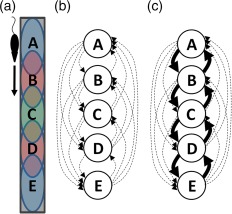Figure 2.

Simple model of reverse replay of direction‐specific place cells. The discovery of symmetric STDP rules in hippocampal area CA3 (Mishra et al., 2016) supports the following simple model of reverse replay. (a) Layout of population‐level CA3 place fields along a linear track. Colored ovals indicate place fields of large neural populations. For example, neural population A is composed of dozens to hundreds of CA3 neurons which all have place fields at the top of the track, while population E is composed of a distinct set of neurons which all have place fields at the bottom of the track. Due to place field directionality (McNaughton et al., 1983; Muller et al., 1994), these particular populations only fire when the rat is running from the top to the bottom of the track and are silent when the rat runs in the reverse direction. Thus, the population sequence during running is always A→B→C→D→E (the sequence E→D→C→B→A never occurs during behavior). (b) Simple network connectivity model. Assuming random initial connectivity, some neurons in population A form excitatory synapses on other neurons in population A (not shown), while some form synapses on neurons in the other populations (arrows). (c) Following a single lap across the track, symmetric STDP between neurons with overlapping fields results in strengthening of synapses in both directions (represented by thicker arrows). Subsequently when the rat is standing in place field E during a ripple, population E is likely to fire first given the current sensory input to the hippocampal circuit. Due to the established plasticity, the sequence E→D→C→B→A can emerge in the ripple despite never occurring during behavior
